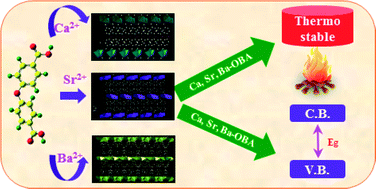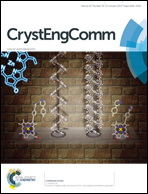Synthesis, structure and band gap energy of a series of thermostable alkaline earth metal based metal–organic frameworks†
Abstract
Three new compounds based on alkaline earth element ions and 4,4′-oxy-bis(benzoic acid) (OBA) were synthesized and characterized. Compound 1, [Ca(H2O)(OBA)], consists of a Ca2O10 dimer, which is connected through OBA anions to form the three-dimensional structure. While in compound 2, [Sr(H2O)(OBA)], SrO7 units are connected to form one-dimensional chains, which are in-turn connected by OBA anions to form the three-dimensional architecture. In compound 3, [Ba2O3(OBA)2], BaO8 and BaO9 units are connected to form the 6-membered two-dimensional sheet structure. These two-dimensional layers are pillared by OBA anions to complete the three-dimensional connectivity. Variable temperature powder X-ray diffraction and thermogravimetric analysis studies show that all these structures are thermally stable up to 400 °C. We have measured the optical band gap energies and results show that the values decrease slightly from 1 to 3. This variation in band gap energy may be due to the different architectures, which affect the states of conduction and valence bands of the materials.


 Please wait while we load your content...
Please wait while we load your content...